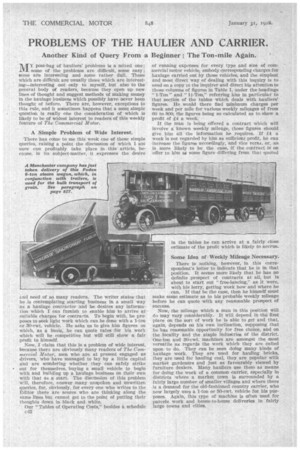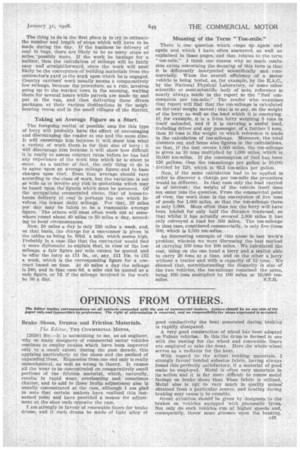PROBLEMS OF THE HAULIER AND CARRIER.
Page 64

Page 65

If you've noticed an error in this article please click here to report it so we can fix it.
Another Kind of Query. From a Beginner : The Ton-mile Again. °
MY post-bag of hauliers' probleins is a mixed one; some of the problems are difficult, some easy ; some are interesting and some rather dull. Those which are difficult are usually those which are interesting—interesting not only to myself, but also to the general body of readers, because they open up new lines of thought and suggest methods of making money in the haulage business which possibly have never been thought of before. There are, however, exceptions to this rule, and it sometimes happens that a most simple question is really one the consideration of which is likely to be of widest interest to readers, of this weekly feature a The Commercial Motor.
need of so many readers. The writer states that he is contemplating starting business in a small way as a haulage contractor and he desires any information which I can furnish to enable him to arrive at suitable charges for contracts. To begin with, he proposes to seek light work which can be done with a 1-ton or 30-cwt. vehicle. He asks us to give him figures on which, as a basis, he can quote rates -for his work which will be competitive but will still show a fair profit to himself.
Now, I claim that this is a problem of wide interest, because there are obviously many readers of The Commercial Motor, men who are at present engaged as
• drivers, who have managed to lay by a little capital a:nd are wondering whether they can safely strike • out for themselves, buying a small vehicle to begin with and building up a haulage business on their own with that as a start. The discussion of this problem will, therefore, answer many unspoken and unwritten queries, for, obviously, for every one who writes to the Editor there are scores who are thinking along the same lines but cannot get to the point of putting their thoughts down in black and white.
Our "Tables of Operating Costs," besides a schedule c42 of running expenses for every type and size of corn• mercial motor vehicle, embody corresponding charges for haulage carried out by those vehicles, and the simplest and most direct way of dealing with this inquiry is to send on a copy to the inquirer and direct his attention to those columns of figures in Table I, under the headings " 1-Ton " and "I1-Ton," referring him in particular to that section of the tables which deals with hauliers' figures. He would there find minimum charges per week and per mile for various weekly mileages of from 60 to 800, the figures being so calculated as to show a profit of 14 a week.
If the man is being offered a contract which will involve a known weekly mileage, those figures should give him all the information he requires. If f4 a week is not regarded by him as sufficient profit, he can increase the figures accordingly, and vice versa, or, as is more likely to be the case, if the contract is on offer to him at some figure differing from that clucked
Some Idea of Weekly Mileage Necessary.
There is nothing, however, in this correspondent's letter to indicate that he is in that position. It seems more likely that he has no definite prospect of contracts at all, but is about to start out "free-lancing," as it were, with his lorry, getting work how and where he can. If that be the case, then he himself must make some estimate as to his probable weekly mileage before he can quote with any reasonable prospect of success.
Now, the mileage which a man in this position will do may vary considerably. It will depend itt the first place on the sort of work he is able to get and that, again, depends on his own inclination, supposing that he has reasonable opportunity for free choice, and on the locality and the staple industries of the district. One-ton and 30-cwt. machines are amongst the most versatile as regards the work which they are called upon to do. They can be seen doing many kinds of haulage work. They are used for hauling bricks, they are used for hauling coal, they are popular with market gardeners and just as favourably viewed by furniture dealers. Many hauliers use them as means for doing the work of a common carrier, especially in districts where a market town is surrounded by a fairly large number of smaller villages and where there is a demand for the old-fashioned country carrier, who now largely uses a 1-ton or 30-cwt. vehicle for his purposes. Again, this type of machine is often used for parcels work and house-to-house deliveries in 'fairly large towns and cities.
The thing to do in the first place is to try to estimate the number and length of stops which will have to be made during the day. If the business be delivery of coal in bags, there are likely to be as many stops as miles, possibly more. If the work be haulage for a builder, then the calculation of mileage will be fairly easy and straightforward, since the work will most likely be the conveyance of building materials from the contractor's yard to the work upon which he is engaged. Country carriers' work usually means a comparatively low mileage, because the procedure, as a rule, involves going up to the market town in the morning, waiting there for several hours while parcels are made up and put in the van, and then delivering these divers packages at their various destinations in the neighbouring towns and in the small villages of the district.
Taking an Average Figure as a Start.
The foregoing recital of possible uses for this type of lorry will probably have the effect of encouraging and discouraging the reader at one and the same time. It will encourage him because it will show him what a variety of work there is for that size of lorry ; it will discourage him because it will show how difficult it is really to assess contract rates before he has had any experience of the work into which he is about to enter. As a matter of fact, the only thing to do is to agree upon an average mileage figure and to base charges upon that. Even that average should vary according to the class of work, but the variation is not so wide as to involve any risk in quotations which may be based upon the figureswhich must be assumed. Of the occupations enumerated above, that of house-tohouse delivery of cOal is perhaps the one which involves the lowest daily, mileage. For that, 20 miles per day may be taken to be a reasonable average figure. The others will most often work out at somewhere round about 40 miles to 50 miles a clay, accord. ing to local circumstances.
Now, 20 miles a day is only 120 miles a week, and, on that basis, the chars6e for a one-tanner is given in the tables as being Is. 104d. a mile, which seems high. Probably in a case like that the contractor would find it more diplomatic to explain that, in view of the low mileage, a fair figure per mile cannot be quoted and to offer the lorry at ill 3s., or, say, ill las. to M a week, which is the corresponding figure for a contract based on time. At 40 miles a day the mileage is 240, and in that case 8d. a mile can be quoted as a safe figure, or 7d. if the mileage involved in the work be 50 a day. Meaning of the Term Ton-mile."
There is one question which crops up again and again and which I have often answered, as well as explained in these pages, and that relates to the term "ton-mile." I think one reason why so much confusion exists concerning the meaning of this term is that it is differently interpreted scientifically and commercially. When the overall efficiency of a motor vehicle is being tested, as, for example, by the R.A.C., by the National Physical Laboratory, or scene other scientific or semi-scientific body of note, reference is nearly always made in the report to the "fuel consumption per ton-mile." The reader who examines that report will find that the ton-mileage is calculated on the total weight moved ; that is to say, on the weight of the lorry as well as the load which it is conveying. If, for example, it is a 5-ton lorry weighing 5 tons in itself unloaded, and if it is carrying a useful load, including driver and any passenger, of a further 5 tons, then 10 tons is the weight to which reference is made in the calculation of ton-mileage. Moreover, the total distance out and home also figures in the calculations, so that, if the test covers 1,000 miles, the ton-mileage is given as 10 tons multiplied by 1,000 miles, which is 10,000 ton-miles. If the consumption of fuel has been 120 gallons, then the tonsnileage per gallon is 10,000 divided by 120, which is 83.8 ton-miles per gallon.
Now, if the same calculation had to he applied in order to discover a charge per ton-mile the procedure would be different. In that case only the load carried is of interest; the weight of the vehicle itself does not enter into the question. From the commercial point of view, the work done is the conveyance of five tons of goods for 1,000 miles, so that the ton-mileage there is only 5,000. More often than not the lorry will have been loaded for only half the distance traversed, so that whilst it has actually covered 1,000 miles it has only conveyed a load for 500 miles. The ton-mileage in that case, considered commercially, is only five times 500, which is 2,500 ten-miles.
An interesting example of this arose In last week's problem, wherein we were discussing the best method of carrying 100 tons for 100 miles. We calculated the cost, using on the one hand a lorry and a trailer able to carry 20 tons at a time, and on the other a lorry without a trailer and with a capacity of 12 tons. We showed that, notwithstanding the disparity in size of the two vehicles, the ton-mileage remained the same, being 100 tons multiplied by 100 miles or 10,000 ton miles. S.T.R.












































































































